Royal Visitors to Merton
Of all the queens consort of England perhaps Katherine of Aragon needs the least introduction. Katherine, the fourth and youngest daughter of Ferdinand of Aragon and Isabella of Castille, was married to Arthur, the elder son of Henry VII and Elizabeth of York, in 1501. This marriage of his heir to a daughter of two of the most powerful monarchs in Europe helped to legitimize the claims of Henry Tudor to the throne of England, as well as establishing his place at the high table of European politics.
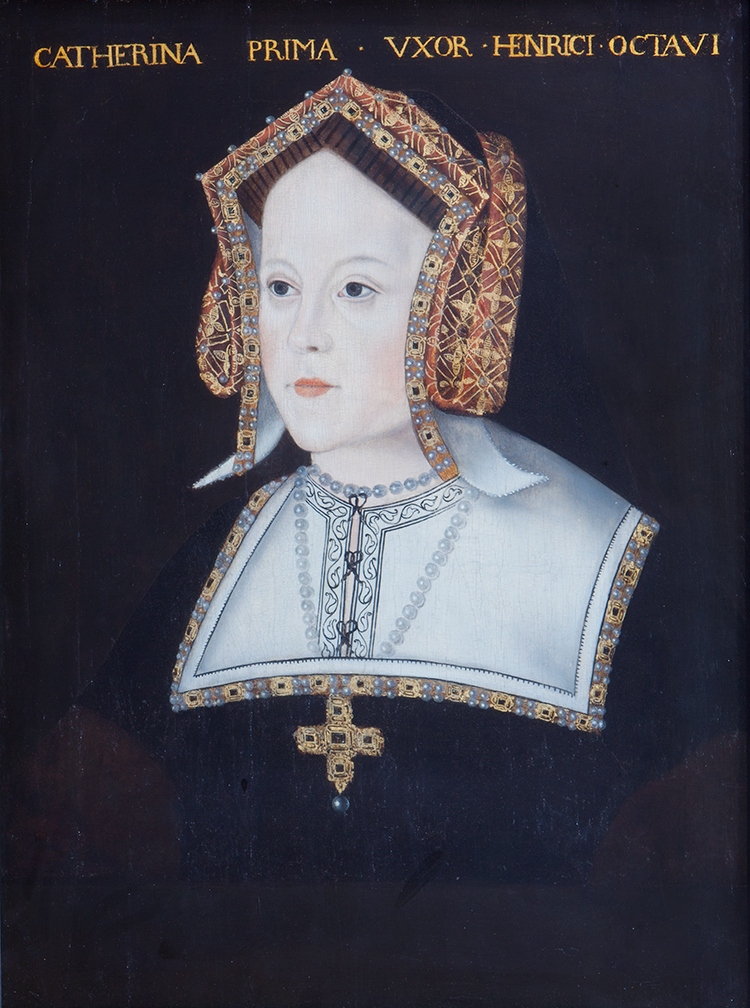
Katherine’s own life was spent in furthering the dynastic ambitions of the men at the centre of her life: her father, her father-in-law and her two husbands. The death of her first husband Arthur, her marriage to his brother Henry in 1509, and the subsequent failure of their marriage to produce a living son and heir are at the heart of England’s national mythology, in which Merton played its own small part. Richard Rawlins, Warden 1509-21, was associated with the court of Henry VIII, serving as the king’s almoner, and accompanying him to France in both 1513 and again in 1520. In between, he had the honour of welcoming Queen Katherine to Merton in 1518, where she stayed in the Warden’s Lodgings while on pilgrimage to the nearby shrine of St Frideswide, to pray for the birth of a healthy son. It was at the least Katherine’s sixth pregnancy in nine years. Four of her previous children had been either stillborn or not survived long past birth. Only the fifth, Mary, was to survive to adulthood. In the event, Katherine’s prayers were not answered, and she was delivered prematurely of a daughter in November that year, who died shortly afterwards before she could be christened.
For many years it was believed that the portrait of Queen Katherine that hangs in the Senior Common Room was a thanks-offering for this hospitality. It is now believed that the portrait came to the college by some means now unknown later in the 16th century, although it is still among the earliest likenesses of Katherine of Aragon.
Henrietta Maria was not the first royal visitor to Merton but her visit was to be the longest. Katherine of Aragon had stayed in the Warden’s Lodgings in the spring of 1518 while on pilgrimage to the shrine of St Frideswide, and Elizabeth I had dined in the Hall in September 1592 during her visit to the University. The visit of Henrietta Maria, in contrast, was to last for nine months. Civil war had broken out in England in the summer of 1642 and by the end of the year much of the south and east of England was in the hands of the Parliamentarian forces, causing Charles I to establish his capital and headquarters in Oxford. His queen meanwhile initially sought refuge in the Netherlands. Henrietta Maria returned to England and arrived in Oxford in July 1643, where she took up residence in the Warden’s Lodgings at Merton from which Warden Nathaniel Brent, an open supporter of Parliament, had made a tactical departure. The majority of fellows and students had also vacated the college in the heat of the Civil War, leaving plenty of accommodation to be occupied by the queen’s entourage.
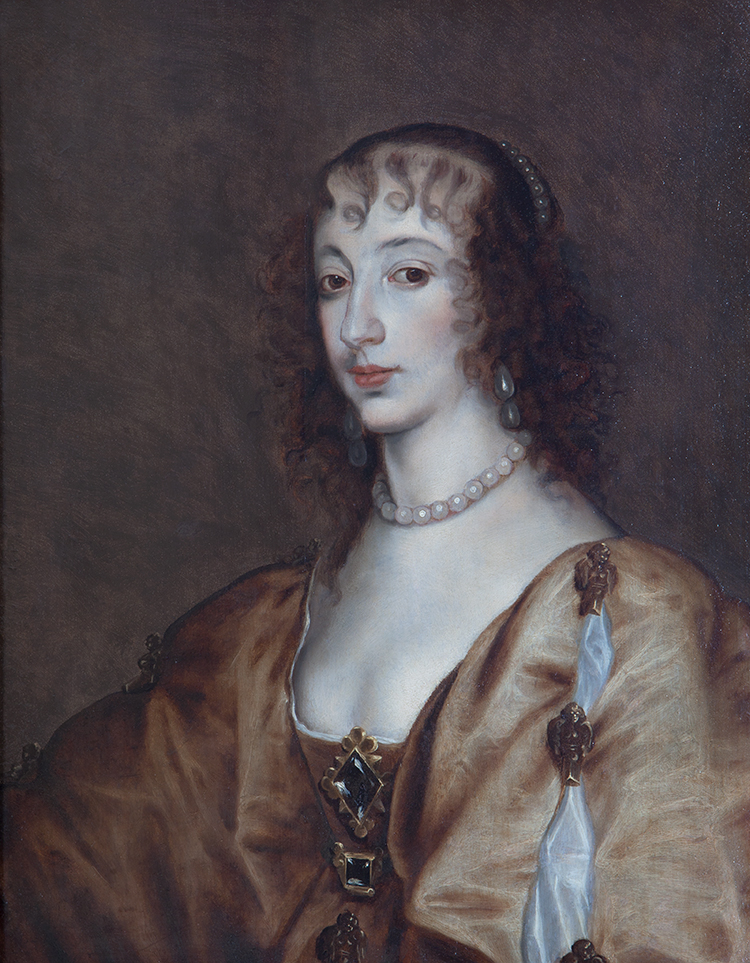
Before the queen’s arrival, doors were opened in the respective walls between Merton and Corpus Christi, and Corpus Christi and Christ Church, to allow the king and queen to visit each other discreetly in their respective lodgings without having to expose themselves to the public gaze. The door between Corpus Christi and Christ Church survives as ‘King Charles’s Gate’. The door between Merton and Corpus Christi was later blocked up, but its outline can still be seen by pedestrians passing through Merton Grove.
By the early spring of 1644, Oxford was under increasing threat from the Parliamentary army. By then the queen was pregnant with what was to be her last child, Princess Henrietta, so for the sake of her unborn child she departed Merton and Oxford and sought refuge in the relative safety of first Bath and then Exeter in the royalist West Country, where she gave birth on 16 June. The Queen was not to see her husband again. After the birth of the princess, Henrietta Maria travelled to France to seek support for the king’s cause, but in the event did not return to England until after the restoration of the monarchy in 1660.
In 1643 Oxford had been a relatively safe refuge from the Civil War but, filled with royal courtiers, soldiers and camp followers in addition to its normal inhabitants, the city was a distinctly unhealthy place. By 1665, however, with plague epidemic in London, Oxford appeared as a safe retreat for the court of Charles II and his queen, Catherine of Braganza. Consequently, in September the king took up residence in the Deanery at Christ Church and a royal consort once again moved into the Warden’s Lodgings at Merton, this time the guest of Sir Thomas Clayton (Warden 1661-93).
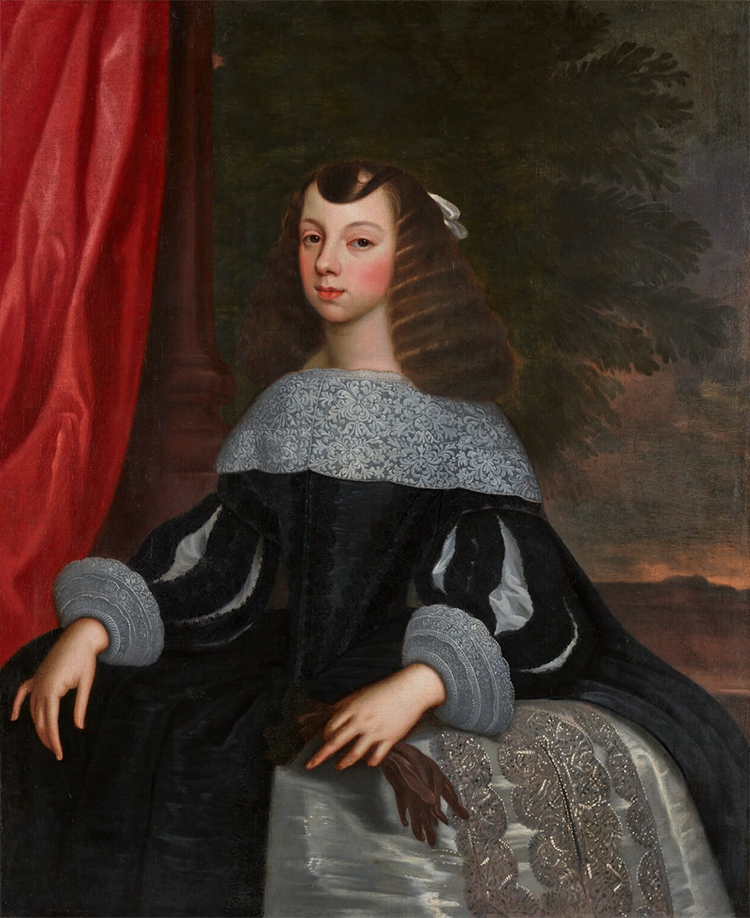
Image: © National Portrait Gallery, London [CC BY-NC-ND]
Catherine had been born to John, Duke of Braganza, in 1638 but two years later her father had been acclaimed King of Portugal, when she too acquired royal status. On the death of her older sister Joana in 1653 she became a very desirable heiress, and was considered as a possible wife for a number of European monarchs. In the event, she married Charles II of England in May 1662. First and foremost it was a dynastic and political alliance. She brought to the marriage territory in North Africa and India, trading privileges in the East Indies and Brazil, and a substantial dowry in gold, while in return Portugal received military and naval support from Britain. Catherine is believed to have been educated in a convent close to the royal palace in Lisbon; she was certainly noted for her quiet, even temper and her piety. Hers was not the sort of personality to have appealed immediately to her husband.
As if to underscore the political nature of this alliance, Catherine found that there were three in her marriage. Charles already had a mistress, Barbara Villiers, two years Catherine’s senior. To add insult to injury, Charles insisted on appointing Barbara Villiers as one of the Ladies of the Queen’s Bedchamber. It is reported that Catherine fainted when Barbara Villiers was first presented to her, and she threatened to return to Portugal when she was informed of the appointment as one of her Ladies of the Bedchamber. Catherine only accepted this fait accompli when the king dismissed most of her Portuguese entourage. It was in this ménage that Catherine found herself when she took up residence at Merton in September 1665.
Catherine’s humiliation only increased when Barbara Villiers gave birth to a healthy son on 28 December: one of several children she bore to Charles II. In contrast, while Catherine of Braganza was pregnant at least three times, none of them was carried to full term. Such was the life of the woman who moved into the Lodgings in September 1665 and who occupied the rooms previously inhabited by her predecessor and mother-in-law, Henrietta Maria, 20 years earlier.
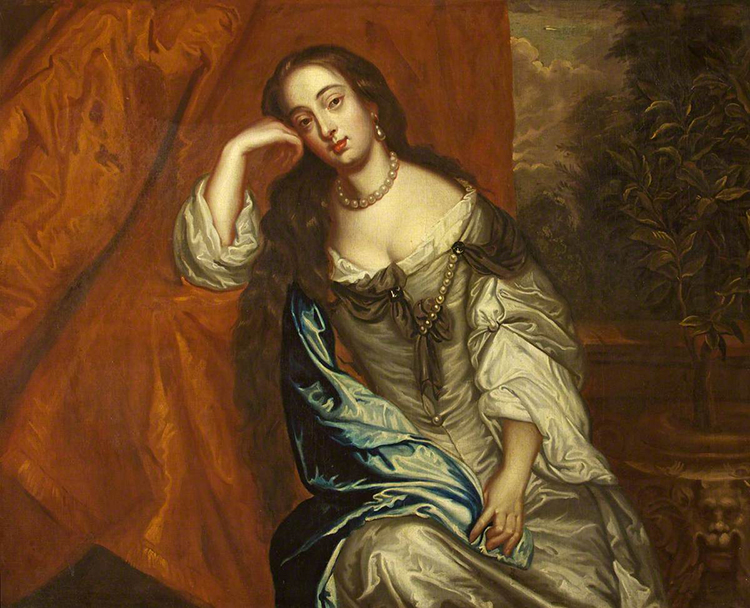
Image: Reproduced by permission of the Provost and Fellows of Worcester College, University of Oxford [CC BY-NC-ND]
There can be few, if any, colleges in Oxford besides Merton that can claim to have housed two sides of a royal love triangle. In September 1665, with plague raging in London, King Charles II brought his court and Parliament to Oxford. Following precedent, the king and his household occupied Christ Church and his queen, Catherine of Braganza, and her attendants stayed at Merton. Among the members of that entourage was the 25-year-old Barbara Villiers, Lady Castlemaine, the king’s mistress. Already married herself, she had become Charles II’s mistress before his marriage in 1662, and the king had insisted on appointing her one of the Queen’s Ladies of the Bedchamber.
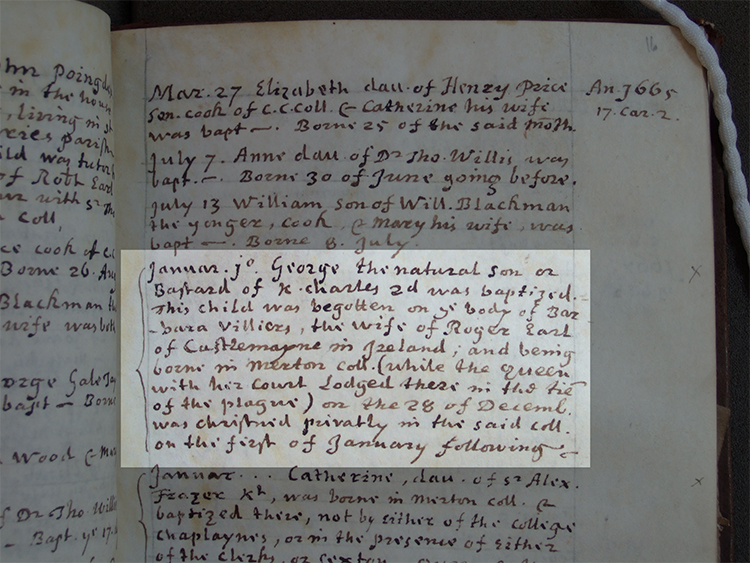
Both the queen and the royal mistress were pregnant while they were at Merton. The latter gave birth to a son on 28 December, who was christened privately in the college chapel on 1 January 1666: the occasion being entered in the chapel register, ‘George the natural son or Bastard of K. Charles 2d was baptized’. Barbara Villiers eventually bore six children, five of them recognized by Charles II as his. But the king took other mistresses and Barbara Villiers fell from favour. Although she had separated from her husband as early as 1662, they remained formally married until his death in 1705, when Lady Castlemaine remarried. She died four years later, in 1709.